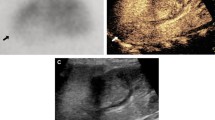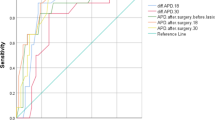Abstract
The strategy for morphological investigations in children with acute pyelonephritis (APN) remains debatable. We studied 70 children (median age 2.0 years) admitted with a first episode of pyelonephritis using a high-resolution ultrasound technique (RUS) and compared the results with 99m technetium–dimercaptosuccinic acid (DMSA) renal scintigraphy. The DMSA scan was abnormal in 62 children (89%). However, using a high-frequency transducer we found abnormal sonogram changes in 61 children (87%), consisting of an increased kidney volume in 42, and/or a thickening of the wall of the renal pelvis in 42, and/or a focal hyper- or hypoechogenicity in 36, and/or a diffuse hyperechogenicity in 31 children. Micturating cystourethrography was performed in all children, revealing vesicoureteral reflux (VUR) in 22 (31%). Among those children with VUR, 4 had a normal DMSA scan, 2 an abnormal RUS, and 2 a normal DMSA scan and RUS. Our data suggest that B-mode RUS performed with a high-frequency transducer by a trained radiologist is nearly as sensitive as the DMSA scan in diagnosing renal involvement in children with unobstructed APN and in predicting VUR.
Similar content being viewed by others
Author information
Authors and Affiliations
Additional information
Received: 9 January 1998 / Revised: 11 July 1998 / Accepted: 28 July 1998
Rights and permissions
About this article
Cite this article
Morin, D., Veyrac, C., Kotzki, P. et al. Comparison of ultrasound and dimercaptosuccinic acid scintigraphy changes in acute pyelonephritis. Pediatr Nephrol 13, 219–222 (1999). https://doi.org/10.1007/s004670050596
Issue Date:
DOI: https://doi.org/10.1007/s004670050596




